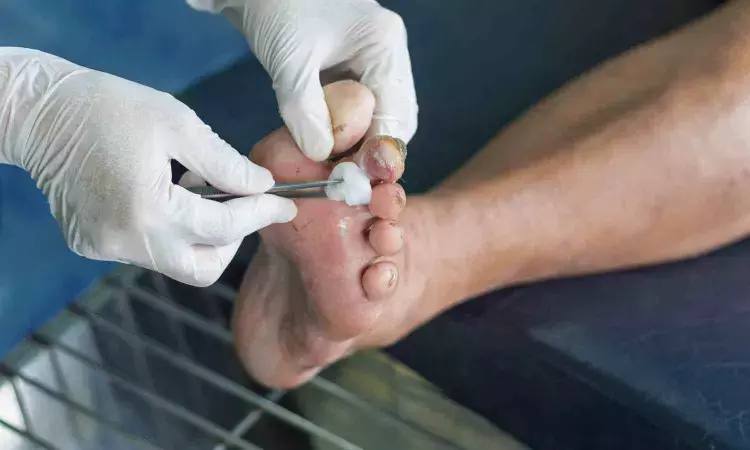- Home
- Medical news & Guidelines
- Anesthesiology
- Cardiology and CTVS
- Critical Care
- Dentistry
- Dermatology
- Diabetes and Endocrinology
- ENT
- Gastroenterology
- Medicine
- Nephrology
- Neurology
- Obstretics-Gynaecology
- Oncology
- Ophthalmology
- Orthopaedics
- Pediatrics-Neonatology
- Psychiatry
- Pulmonology
- Radiology
- Surgery
- Urology
- Laboratory Medicine
- Diet
- Nursing
- Paramedical
- Physiotherapy
- Health news
- Fact Check
- Bone Health Fact Check
- Brain Health Fact Check
- Cancer Related Fact Check
- Child Care Fact Check
- Dental and oral health fact check
- Diabetes and metabolic health fact check
- Diet and Nutrition Fact Check
- Eye and ENT Care Fact Check
- Fitness fact check
- Gut health fact check
- Heart health fact check
- Kidney health fact check
- Medical education fact check
- Men's health fact check
- Respiratory fact check
- Skin and hair care fact check
- Vaccine and Immunization fact check
- Women's health fact check
- AYUSH
- State News
- Andaman and Nicobar Islands
- Andhra Pradesh
- Arunachal Pradesh
- Assam
- Bihar
- Chandigarh
- Chattisgarh
- Dadra and Nagar Haveli
- Daman and Diu
- Delhi
- Goa
- Gujarat
- Haryana
- Himachal Pradesh
- Jammu & Kashmir
- Jharkhand
- Karnataka
- Kerala
- Ladakh
- Lakshadweep
- Madhya Pradesh
- Maharashtra
- Manipur
- Meghalaya
- Mizoram
- Nagaland
- Odisha
- Puducherry
- Punjab
- Rajasthan
- Sikkim
- Tamil Nadu
- Telangana
- Tripura
- Uttar Pradesh
- Uttrakhand
- West Bengal
- Medical Education
- Industry
Use of microneedles may promote diabetic wounds healing, suggests study

The global population of patients with diabetic wounds is expected to rise to between 9.1 million to 26.1 million by 2030. Diabetic wounds severely impact patients’ quality of life, both physically and mentally while also imposing a substantial economic burden on healthcare systems.
Current treatment methods for diabetic wounds include surgical debridement, negative pressure wound therapy, vascularized flaps and different types of local dressings. Among these dressings, commonly used options include gauze, metal ion dressings, hydrogel dressings and platelet-rich plasma dressings. However, traditional dressings have limited drug loading capacity and permeability, and are unable to deliver active medications to the deep wound bed.
In recent years, microneedles have become a research focus in wound management due to their advantages of high drug load/delivery capabilities, minimal invasiveness, convenience and strong adhesion. These attributes significantly reduce patient discomfort and improve compliance. Microneedles enhance the efficiency and permeability of transdermal drug delivery by penetrating the skin barrier and incorporating drugs, proteins, nanoparticles and other therapeutic agents, effectively transporting them to the wound bed.
At present, there is a lack of summary articles on the application of microneedles of different structures and materials to diabetic wounds. This also hampers the development of microneedle dressings related to diabetic wounds.
To that end, in a review published in the KeAi journal Chinese Journal of Plastic and Reconstructive Surgery, a group of researchers from China summarizes the materials of microneedles, techniques, structure, design, release mechanism, classification of delivered substances and their effects on different stages of wound healing.
“The structural composition and material selection of microneedles influence their efficacy in treating diabetic wounds,” explains corresponding author of the study, Youbai Chen, a professor in plastic and reconstructive surgery at the First Medical Center of Chinese PLA General Hospital in Beijing. "Microneedles can promote diabetic wound healing through several mechanisms, such as antibacterial, anti-inflammatory, antioxidant, hypoglycemic and angiogenic activities at different stages of the healing process.”
“In conclusion, microneedles are promising drug delivery systems for the treatment of diabetic wounds,” adds first author Chun Liang. “We hope that our summary will be enlightening and instructive for further research on microneedle dressings."
Reference:
Chun Liang, Ren Wang, Tian He, Dongsheng Chen, Guangliang Zhang, Xiangye Yin, Hongyu Wang, Jiale Xie, Yujing Li, Youbai Chen, Revolutionizing diabetic wound healing: The power of microneedles, Chinese Journal of Plastic and Reconstructive Surgery, https://doi.org/10.1016/j.cjprs.2023.12.004.
Dr Kamal Kant Kohli-MBBS, DTCD- a chest specialist with more than 30 years of practice and a flair for writing clinical articles, Dr Kamal Kant Kohli joined Medical Dialogues as a Chief Editor of Medical News. Besides writing articles, as an editor, he proofreads and verifies all the medical content published on Medical Dialogues including those coming from journals, studies,medical conferences,guidelines etc. Email: drkohli@medicaldialogues.in. Contact no. 011-43720751


